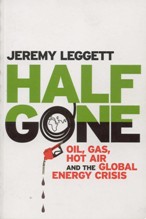Half Gone – Oil, Gas, Hot Air and the Global Energy Crisis

Jeremy Leggett
Published by: Portobello Books Ltd
Publication date: 2005
ISBN: 1-84627-004-9
List price: £12.99
312 pp
www.portobellobooks.com
Global warming, propelled by reckless consumption of fossil fuels, has emerged as the foremost environmental issue of the 21st Century. In Half Gone Jeremy Leggett pins the blame squarely on ‘Big Oil’; not only have the Oil Men and their allies denied the link between hydrocarbons and warming, they have concealed an imminent collapse in oil supply. Thus environmental catastrophe will be preceded by an energy crisis that will cause economic and political meltdown. Luckily a few good men can see the ailing state of the planet and we may be redeemed if we follow their council.
‘Peak Oil’ adherents argue, correctly, that most giant fields were discovered a generation ago and we are now consuming far more oil than we are finding. They further maintain that supply has effectively peaked and that we have embarked on an irreversible decline. Of course, had we oil in unlimited quantities we could not burn it anyway as the impact on global warming would be catastrophic. However, salvation is at hand in alternative energy, which must be harnessed without delay.
Leggett’s selective use of facts and expert opinion do not make his case for a production crisis - nor does his contempt for all those that disagree with him. Many analysts with comparable credentials to the Peak Oil advocates see no short-term problem. For example the book ignores the forecasts of consultancies such as Cambridge Energy Research Associates (CERA), under the Chairmanship of Daniel Yergin, who predict no near- or medium-term supply crisis. Others simply accept that, unless OPEC decides to open its books, we cannot tell either way. That is not a comfortable position, but it is an honest one.
On man’s contribution to global warming Leggett is on surer ground. Even here, though, he fails to deal adequately with the key issue. The case for climate change is proven. The critical issue is the precise relationship between greenhouse gas levels and temperature, because this will dictate how much more fossil fuel we can burn. Attempts to mitigate warming by sequestration of CO2 are dismissed out-of–hand.
As the book exaggerates the difficulties of maintaining oil production, so it minimises the challenges of a shift to renewables. The direction of change is inevitable but the rate is crucial if we are to survive the transition to a Post-Hydrocarbon Age. Accepting Sheikh Yamani’s claim that the breakthrough could be made in a decade is simply not realistic. Jeremy Leggett has performed an invaluable service in making us face up to the problem of global warming, but in refusing to acknowledge that continued hydrocarbon use is part of the answer he cannot offer a workable solution.
Joe Brannan
Shell International Exploration and Production